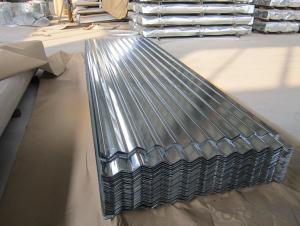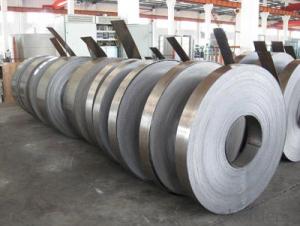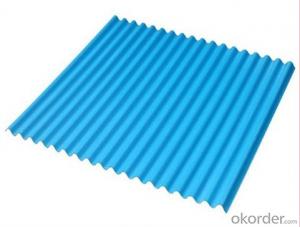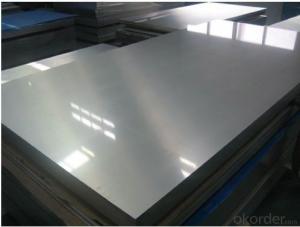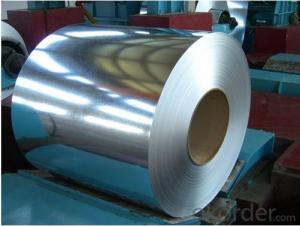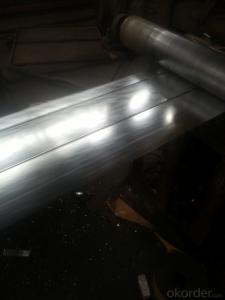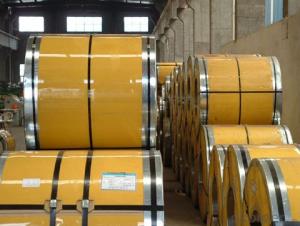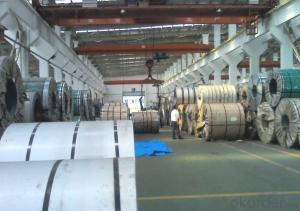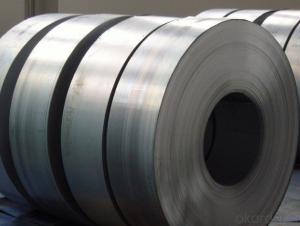Hot Dipped Galvanized Steel Coil/Hot Dipped Galvanized Steel Strips Coil/Zinc Coated Steel Coil
- Loading Port:
- Tianjin
- Payment Terms:
- TT OR LC
- Min Order Qty:
- 500 m.t.
- Supply Capability:
- 100000 m.t./month
OKorder Service Pledge
OKorder Financial Service
You Might Also Like
Hot Dipped Galvanized Steel Coil/Hot Dipped Galvanized Steel Strips Coil/Zinc Coated Steel Coil Specifications:
Steel strips coils galvanized
Material: Q195, Q215, Q235, Q345B, SGCC, DX51D+Z
Thickness:0.75-4.5mm
Width:32-750mm
Zinc coating: 60-550g/m2
Hot Dipped Galvanized Steel Coil/Hot Dipped Galvanized Steel Strips Coil/Zinc Coated Steel Coil Description:
Galvanized steel coil are widely used in the construction industry, as raw material for the production of corrugated panels, fencing products, drywall panel profiles, ventilation systems etc. Recommended for both outside and inside usage, galvanized steel has a high resistance to corrosion in different environments, due to a protective layer of zinc of 100 – 180 grams per square metre.
Main Features of Hot Dipped Galvanized Steel Coil/Hot Dipped Galvanized Steel Strips Coil/Zinc Coated Steel Coil:
Hot-dip galvanized steel coils are produced by immersing steel in a zinc bath. An appropriate galvanizing process requires a pretreatment process during which the steel passes through different baths which prepare the surface for zinc coating. In this stage, chemicals are used to clean the surface of the steel. After the chemical treatment, the steel coils pass through a bath of melted zinc at temperatures around 460 ° C. The resulting uniform coating is finished through a process of skin-passing to provide smooth and shiny appearance of the finished product. To store for a longer period, the hot-dip galvanized coils can be delivered with a final oil coating, according to the customer’s demand.
Hot Dipped Galvanized Steel Coil/Hot Dipped Galvanized Steel Strips Coil/Zinc Coated Steel Coil Images:
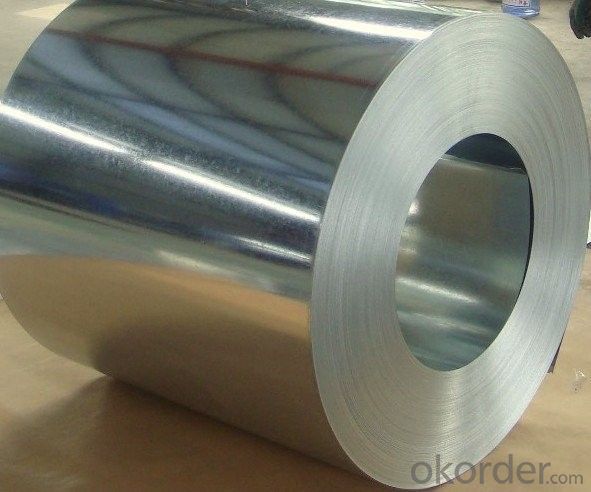
FAQ:
What certificates do you have for your products?
ISO
- Q:How are steel strips polished for aesthetic purposes?
- Steel strips are polished for aesthetic purposes using a combination of mechanical processes such as grinding, buffing, and polishing. These techniques involve the use of abrasive materials and machines to remove surface imperfections and create a smooth, shiny finish on the steel strips. Additionally, chemical treatments may be applied to enhance the polishing process and achieve the desired aesthetic results.
- Q:How are steel strips processed for flexibility?
- Steel strips are processed for flexibility through a series of techniques such as cold rolling, annealing, and tempering. Cold rolling reduces the thickness of the steel strip while increasing its length, making it more flexible. Annealing involves heating the strip and then slowly cooling it to enhance its ductility. Tempering further improves flexibility by reheating the steel and then cooling it rapidly. These processes help to manipulate the microstructure of the steel, allowing it to bend and flex without breaking.
- Q:Can steel strips be used for making architectural elements?
- Yes, steel strips can be used for making architectural elements. Steel strips are versatile and can be shaped, bent, and welded into various architectural designs and structures. They offer strength, durability, and a sleek aesthetic, making them suitable for applications such as beams, columns, cladding, and decorative features in buildings.
- Q:What are the factors that affect the machinability of steel strips?
- The factors that affect the machinability of steel strips include the type and composition of the steel, its hardness and microstructure, the presence of impurities and alloying elements, the cutting tools and their condition, cutting speed and feed rate, lubrication and cooling, as well as the machine setup and stability.
- Q:How do steel strips contribute to improving product performance in various applications?
- Steel strips contribute to improving product performance in various applications in several ways. Firstly, steel strips provide exceptional strength and durability, making them suitable for demanding environments and heavy-duty applications. They can withstand high levels of stress, impact, and pressure without deforming or breaking, ensuring long-lasting performance. Secondly, steel strips offer excellent corrosion resistance, protecting products from degradation due to exposure to moisture, chemicals, or extreme weather conditions. This resistance helps maintain the product's performance and extends its lifespan, reducing maintenance costs. Moreover, steel strips can be easily shaped and formed into precise dimensions, allowing manufacturers to create customized products that meet specific performance requirements. This versatility enables the design of efficient and optimized components, enhancing overall product performance. Additionally, steel strips have excellent thermal conductivity, enabling efficient heat transfer and dissipation in applications such as heat exchangers or electrical conductivity for applications like connectors. This attribute ensures proper functioning and prevents overheating, improving product performance and reliability. Overall, the use of steel strips enhances product performance by providing strength, durability, corrosion resistance, versatility in design, and efficient thermal and electrical conductivity in various applications.
- Q:Can steel strips be heat-treated?
- Yes, steel strips can be heat-treated. Heat treatment processes such as annealing, tempering, quenching, and hardening can be applied to steel strips to alter their mechanical properties and improve their strength, hardness, and durability.
- Q:Are steel strips suitable for the manufacturing of pressure vessels?
- Yes, steel strips are suitable for the manufacturing of pressure vessels. Steel strips provide high strength, durability, and resistance to pressure, making them a reliable choice for constructing pressure vessels. Additionally, steel strips can be easily formed and welded into various shapes and sizes, allowing for flexibility in designing and manufacturing pressure vessels to meet specific requirements.
- Q:How are steel strips used in the manufacturing of bearings?
- Steel strips are commonly used in the manufacturing of bearings due to their strength, durability, and ability to withstand high temperatures. These strips serve as the primary material for the inner and outer rings of the bearing, providing a stable and rigid structure. The manufacturing process begins by selecting high-quality steel strips that are precisely cut and shaped to form the rings. The strips are often heat-treated to enhance their mechanical properties, such as hardness and toughness, which are crucial for bearing performance. Once the rings are formed, they undergo further machining processes to achieve the required dimensions and surface finish. This ensures that the bearings fit accurately and smoothly into the desired application, reducing friction and optimizing performance. Steel strips also play a vital role in maintaining the alignment and stability of the bearing components. They act as a support for the balls or rollers, which are responsible for the rotational movement of the bearing. The strips provide a firm surface for the rolling elements to move against, reducing friction and enabling the bearing to operate efficiently. Furthermore, steel strips are often coated with anti-corrosion materials or lubricants to protect them from wear, rust, and other environmental factors. This extends the lifespan of the bearing and improves its overall performance in various applications. In summary, steel strips are an essential component in the manufacturing of bearings. They provide strength, durability, and stability to the bearing structure, enabling it to withstand high loads, resist wear, and operate smoothly.
- Q:What are the common grades of steel used for making strips?
- The common grades of steel used for making strips vary depending on the specific application and desired properties. However, some commonly used grades include: 1. Low carbon steel (C1008/C1010): This grade of steel is often used for making strips due to its excellent formability and weldability. It is commonly used in industries such as automotive, construction, and appliances. 2. Medium carbon steel (C1045/C1050): This grade of steel offers better strength and hardness compared to low carbon steel. It is often used in applications where higher strength and wear resistance are required, such as in the manufacturing of cutting tools or machinery parts. 3. High carbon steel (C1095): High carbon steel strips offer the highest strength and hardness among common grades. They are commonly used for making springs, saw blades, and other high-stress applications where durability and resilience are crucial. 4. Stainless steel (e.g., 304/316): Stainless steel strips are widely used due to their excellent corrosion resistance and aesthetic appeal. They are commonly used in applications such as kitchenware, automotive trims, and architectural components. 5. Alloy steel (e.g., 4140/4340): Alloy steel strips are made by adding various alloying elements to enhance specific properties such as strength, toughness, or heat resistance. They are commonly used in applications requiring high strength and durability, such as in the manufacturing of gears, shafts, or aerospace components. It is important to note that these are just a few examples of the common grades of steel used for making strips, and there are numerous other grades available, each with its own unique properties and applications. The selection of the appropriate grade depends on factors such as the intended use, required mechanical properties, and environmental conditions the strips will be exposed to.
- Q:How are steel strips tempered for improved toughness?
- Steel strips are tempered for improved toughness through a process known as heat treatment. This process involves heating the steel strips to a specific temperature, typically between 300-700 degrees Celsius, and then cooling it rapidly. This rapid cooling is done by quenching the steel in oil, water, or air, depending on the desired level of toughness. During the heating stage, the steel strips undergo a transformation known as austenitization, where the crystal structure of the steel changes. This results in the formation of a hard and brittle phase called martensite. While martensite provides high hardness, it lacks toughness and is prone to cracking under stress. To improve toughness, the steel strips are then subjected to the tempering process. During tempering, the steel strips are reheated to a lower temperature, typically between 150-300 degrees Celsius, and held at that temperature for a specific duration of time. This allows the martensite to transform into a more ductile phase called tempered martensite. The tempering process helps to relieve internal stresses within the steel strips, reduce brittleness, and improve toughness and ductility. It also allows for the adjustment of the final mechanical properties based on the specific requirements of the application. Overall, steel strips are tempered for improved toughness by subjecting them to a carefully controlled heat treatment process, which transforms the hard and brittle martensite phase into a more ductile tempered martensite phase. This ensures that the steel strips possess the desired combination of hardness and toughness for various industrial applications.
1. Manufacturer Overview |
|
|---|---|
| Location | |
| Year Established | |
| Annual Output Value | |
| Main Markets | |
| Company Certifications | |
2. Manufacturer Certificates |
|
|---|---|
| a) Certification Name | |
| Range | |
| Reference | |
| Validity Period | |
3. Manufacturer Capability |
|
|---|---|
| a)Trade Capacity | |
| Nearest Port | |
| Export Percentage | |
| No.of Employees in Trade Department | |
| Language Spoken: | |
| b)Factory Information | |
| Factory Size: | |
| No. of Production Lines | |
| Contract Manufacturing | |
| Product Price Range | |
Send your message to us
Hot Dipped Galvanized Steel Coil/Hot Dipped Galvanized Steel Strips Coil/Zinc Coated Steel Coil
- Loading Port:
- Tianjin
- Payment Terms:
- TT OR LC
- Min Order Qty:
- 500 m.t.
- Supply Capability:
- 100000 m.t./month
OKorder Service Pledge
OKorder Financial Service
Similar products
New products
Hot products
Hot Searches
Related keywords






